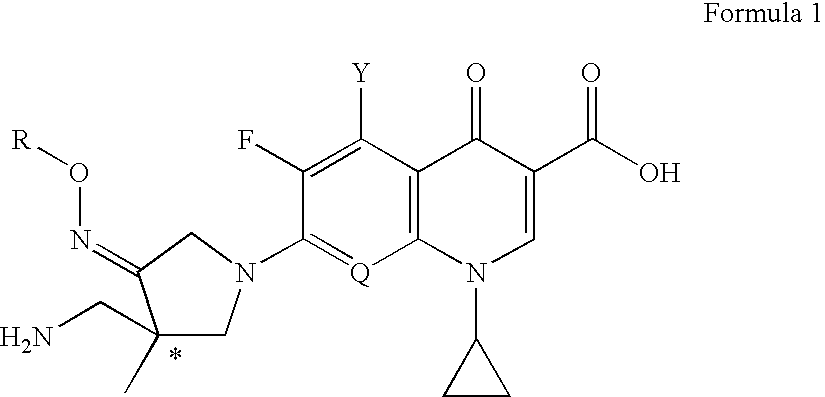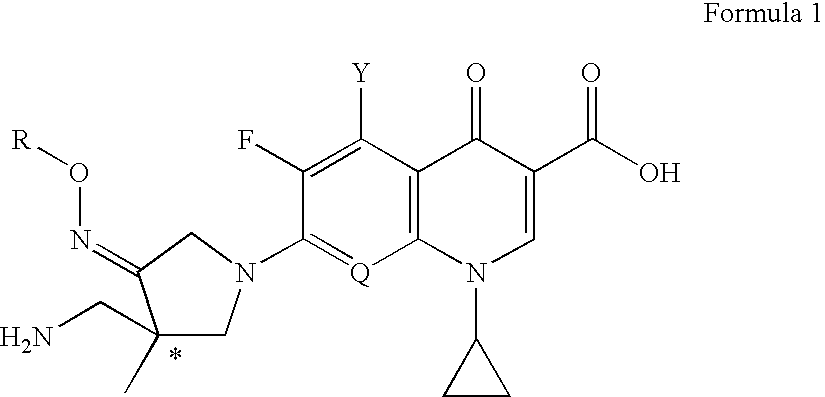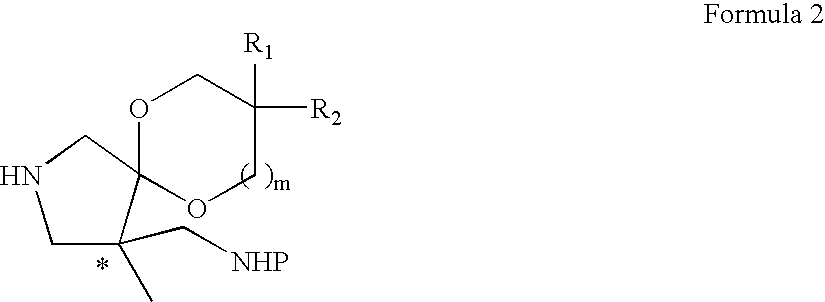Optically active quinoline carboxylic acid derivatives with 7-pyrrolidine substituents causing optical activity and a process for the preparation thereof
a technology of pyrrolidine and quinolone carboxylic acid, which is applied in the field of optically active quinoline carboxylic acid derivatives, can solve the problems of weak potency of quinolone antibacterial agents, inability to deduce them from the prior art, and inability to correspond in vitro antibacterial activity with in vitro activity, etc., to achieve excellent pharmacokinetic profiles, potent antibacterial activity, and strong antibacterial activity
- Summary
- Abstract
- Description
- Claims
- Application Information
AI Technical Summary
Benefits of technology
Problems solved by technology
Method used
Image
Examples
preparation example 2
Preparation of 2-Benzyl 4-Ethyl 4,8,8-Trimethyl-6,10-dioxa-2-azaspiro[4.5]decane-2,4-dicarboxylate
To the solution of the compound (214 g) obtained from the above preparation example 1 in n-heptane (1 l) was added neopentylglycol (219 g), followed by paratoluenesulfonic acid (35 g), and then the solution was refluxed for 6 hr. The reaction mixture was concentrated under reduced pressure. The residue was diluted in CH.sub.2 Cl.sub.2 (1 l), and washed with saturated NaHCO.sub.3 solution and water. The organic layer was dried over anhydrous magnesium sulfate, concentrated under reduced pressure, and the residue was purified by silica gel column chromatography (ethyl acatate:n-hexane 1:6) to obtain the desired compound (235 g, 85.7%).
.sup.1 H-NMR(CDCl.sub.3, ppm) 0.72 (3H, s), 1.19 (3H, s), 1.25.about.1.28 (3H, m), 1.34 (3H, s), 3.34-3.60 (6H, m), 3.96 (1H, d, J=10.8 Hz), 4.08 (1H, d, J=11.4 Hz), 4.11-4.16 (1H, m), 4.23-4.25 (1H, m), 5.14 (2H, d, J=4.6 Hz), 7.30-7.38 (5H, m).
preparation example 3
Preparation of Ethyl 4,8,8-Trimethyl-6,10-dioxa-2-azaspiro[4.5]decane-4-carboxylate
To the solution of the compound (230 g) obtained from the preparation example 2 in methanol (2 e) was added 10% Pd--C 11.5 g, and the solution was stirred for 1.5 hr under hydrogen atmosphere. The reaction mixture was filtered and concentrated under reduced pressure to obtain the desired compound (131 g, 86.8%).
.sup.1 H-NMR(CDCl.sub.3, ppm) 0.30 (3H, s), 0.75 (3H, s), 0.82-0.86 (6H, m), 2.10 (1H, s), 2.26 (1H, d, J=12.0 Hz), 2.44 (1H, d, J=12.2 Hz), 2.97-3.11 (4H, m), 3.26 (1H, d, J=11.7 Hz), 3.70-3.79 (2H, m).
preparation example 4
Preparation of Ethyl 2-Benzyl-4,8,8-trimethyl-6,10-dioxa-2-azaspiro[4.5]decane-4-carboxylate
To the solution of the compound (128.3 g) obtained by the preparation example 3 in acetonitrile (1 l) was added potassium carbonate (103 g), followed by benzylchloride (69 ml), and the solution was refluxed for 16 hr. The reaction mixture was cooled at room temperature, filtered and concentrated under reduced pressure. The residue was purified by silica gel column chromatography CH.sub.2 Cl.sub.2 100%) to obtain the desired compound (204.2 g, 93.1%).
.sup.1 H-NMR(CDCl.sub.3, ppm) 0.66 (3H, s), 1.16 (3H, s), 1.22.about.1.28 (3H, m), 1.39 (3H, s), 2.65 (1H, d, J=9.0 Hz), 2.83 (1H, d, J=10.0 Hz), 3.10 (1H, d, J=9.8 Hz), 3.19 (1H, d, J=9.3 Hz), 3.34-3.39 (2H, m), 3.45-3.51 (2H, m), 3.61 (1H, d, J=13.4 Hz), 3.74 (1H, d, J=13.2 Hz), 4.12-4.20 (2H, m), 7.21-7.35 (5H, m).
PUM
| Property | Measurement | Unit |
|---|---|---|
| temperature | aaaaa | aaaaa |
| temperature | aaaaa | aaaaa |
| temperature | aaaaa | aaaaa |
Abstract
Description
Claims
Application Information
 Login to View More
Login to View More - R&D
- Intellectual Property
- Life Sciences
- Materials
- Tech Scout
- Unparalleled Data Quality
- Higher Quality Content
- 60% Fewer Hallucinations
Browse by: Latest US Patents, China's latest patents, Technical Efficacy Thesaurus, Application Domain, Technology Topic, Popular Technical Reports.
© 2025 PatSnap. All rights reserved.Legal|Privacy policy|Modern Slavery Act Transparency Statement|Sitemap|About US| Contact US: help@patsnap.com



